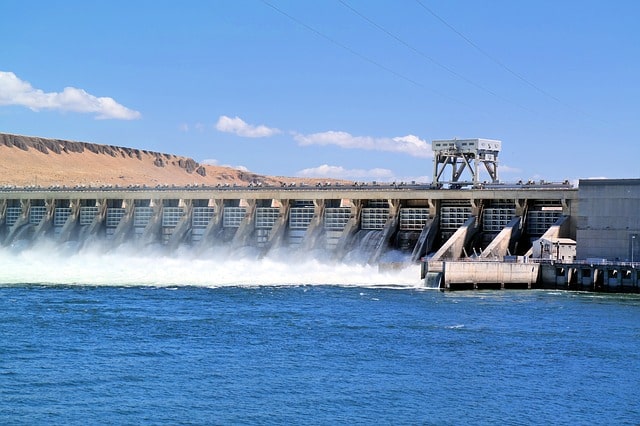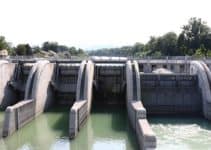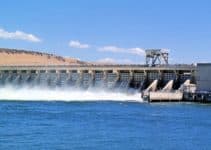Hydropower is, by far, the most used form of renewable energy resource in the world. It’s also the oldest method of power generation. Statistically, the world’s electricity produced by hydropower stands at 21%, and the total number of people supplied by energy generated from hydropower plants is a staggering 1,250,000,000. A record 25 countries rely on hydropower for 90% of their electricity. All these statistics point to the fact that hydropower will still rule the world although other renewable forms of energy like solar and wind are fast gathering steam.
Hydropower is simply the process of harnessing the kinetic energy from moving water to produce power. Hydropower is classified as a renewable energy due to the fact that the water cycle is continually renewed by the sun. Hydropower was first used in mechanical millings like grinding grain. In the modern world, hydropower plants utilize turbines and generators to produce electricity.
How Does a Hydroelectric Power Plant Works?
For power to be generated, three things must be present; flowing water, a turbine, and a generator. Flowing water from the dam or upstream river strikes the turbine, which causes it to turn. The turbine is connected to the generator through a shaft. So, when the turbine turns, the shaft also turns causing the generator to start running, eventually, producing power.
The principle of hydroelectric power is similar to that of wind energy which turns the wheels of the turbine by its energy. Hydroelectric power uses the natural flow of water to give mechanical energy to turbines to produce electricity. The water flows continuously to provide energy. Gravitational energy gives water kinetic energy required for the flow.
In normal cases the ordinary flow of water is enough for its working like for home electricity; but in other cases its flow and efficiency has to be increased which can be done by shafting of water along channels and penstocks which would increase the output.
The operation of a generator is sophisticated. It operates on a principle that when a magnet is pushed past a conductor, it triggers electricity to flow. In a large scale generator, electromagnets are developed by simply circulating DC (direct current) via loops of wire wrapped around heaps of magnetic steel laminations, known as field poles. These field poles are placed upon the boundary of the rotor. The rotor is normally connected to the turbine shaft and spins at a set speed. As the rotors spin, it triggers the field poles, also known as the electromagnets, to go beyond the conductors placed in the stator. This, eventually, results in flow of electricity. It also results in voltage generation at the output terminals of the generator.
The components of a hydroelectric power plant below pretty much explain how it works:
Components of a Hydroelectric Power Plant
- Dam
Dams are constructed to elevate the river’s water level in order to create falling water. A dam also controls the water flow. The water body formed (reservoir) is, essentially, stored energy.
- Turbine
The falling water harbors a lot of energy such that when it falls on the turbine, it causes it to spin. A water turbine has a lot in common with a windmill; it’s just that the energy is supplied by water and not wind. The spinning turbine converts the kinetic (motion) energy of water into mechanical energy.
- Generator
The generator is typically connected to the turbine via shafts. When the turbine spins, the generators also spin. The generator converts the mechanical energy into electricity. Hydroelectric power plant generators work the same way as generators used in other power plants.
- Transmission lines
Transmission lines convey electricity from the hydroelectric power plants to the end users like homes and businesses.
Types of Hydropower Turbines
Hydropower turbines are classified into two; impulse turbines and reaction turbines. The kind of turbine selected for a certain project pretty much hinges on the height of standing water, commonly known as ‘’head”. Below is a highlight of the two main classifications of hydropower turbines:
- The impulse turbine
This is the entry level type of turbine utilized in most hydropower generation plants. The functionality of an impulse turbine is rather interesting. A fast moving liquid is passed through a thin nozzle at the blades of the turbine to allow the blades to rotate. The blades fitted on an impulse turbine are normally bucket shaped, so they arrest the liquid and channel it off at an angle.
In other scenarios; the liquid redirected to where it originated from. It happens that way because the process offers the best transfer of energy from the liquid to the turbine. In a nutshell, the liquid is forced to strike the turbine at supersonic speeds. Those constant energy impulses are the fundamentals of the working of the impulse turbine.
Most water turbines revolve around the impulse turbine, even though others use the reaction turbine model. Impulse turbines are most preferred because they are easy to develop, have easy designs and are a whole lot easier to maintain. The impulse turbine is further subdivided into:
- Cross-flow turbine: It’s drum like in shape. Most water turbines feature axial and radial flows. However, in a cross-flow turbine, the fluid passes through the turbine diagonally or across the blades. The unique thing about this kind of turbine is that it permits water to flow through its blades twice. During the first pass, water flows from the outer ends of the blades to the inside, while the second flow is from the inside of the blade back out. The cross-flow also features a guide vane at the entry point of the turbine, which channels the flow of liquid to a limited area of the runner. The cross-flow was designed to take up enormous water flows and lower heads compared to the Pelton.
- Pelton: This impulse type water turbine harvests energy from the impulse of flowing water. Its main components include breaking jet, nozzle, runners, buckets and casing. It’s used mainly for high head hydropower schemes. It comes with the benefit of small size, compact structure, high efficiency, low operation and maintenance cost. The shaft arrangement is either horizontal or vertical and may come with single nozzle, twin or multi-nozzle. The shaft comes along with attributes like good structure, big capacity, high head, and multi-nozzle.
Components of the impulse turbine
- Rotor: It’s also known as the wheel and located on the shaft. All the blades of the turbine are attached to the rotor. The forces applied to the blade by the falling water are transferred to the rotors, which increases the velocity of the spinning turbine.
- Blades: the concave shaped blades are normally attached to the rotary. The falling water strikes the blades and changes their direction.
- Nozzle: The main function of the nozzle is to regulate flow of water. A spear needle or conical work is placed inside the nozzle in axial direction. The divulging nozzle is responsible for converting water pressure energy into kinetic energy helping in the formation of water jets. The high-speed water jets hit the turbine blades, hence, rotating it.
- Baking nozzle: This is situated in the opposite direction to the main nozzle. The braking nozzle is chiefly used to slow down the wheel or stop it altogether.
- Casing: This is the outer layer of the turbine that protects the turbine from the harsh external environment. The key function of the casing is to mitigate water discharge to the tail race from the vane.
- Reaction turbines
Reaction turbines work in a slightly different way to impulse turbines. Here, the blades are set in a lot bigger volume of fluid and spins as the fluid flows through them. This kind of turbine does not alter the direction of fluid flow instantly as the impulse turbine does. It just spins while the fluid flows through as it goes past the blades. Reaction turbine’s features have a lot in common with the winds turbine. An example of a turbine that falls under reaction turbines is the propeller turbine.
Propeller turbines
Consists of a runner along with 3 to 6 blades, which continually come into contact with water. The main components of the reaction turbine apart from the runner include scroll case, draft tube, and wicket gates. The different kinds of propeller turbines include straflo, bulb turbine, Kaplan, and tube turbine. Propeller turbines are further subdivided into:
Kinetic energy turbines: They are also known as free flow turbines. They produce electricity as result of the kinetic energy contained in falling water instead of energy from the head. These types of turbine can work in rivers, human-made channels, ocean currents or tidal waters. Kinetic turbine systems use natural pathway of streams. They don’t require any form of water diversion via pipes, river beds or human-made channels. They also don’t need large scale civil works. Nonetheless, they can utilize existing structures like channels, tailraces, and bridges.
Francis turbines: Francis turbines consist of a runner along with fixed buckets or vanes, normally 9 or more. Introduction of water just above the runner causes it to rotate. Other components of the Francis apart from the runner include wicket gates, draft tube, and scroll gates.


